Introduction
As the demand for better service augments and customers become more sophisticated than traditional customers, technology is the new wave of innovation that is making businesspersons serve clients with the most desirable satisfaction. Believed to have a better way of delivering services and hastening processes in companies, Information Technology (IT) systems have been in demand for their perceived operational efficiency in companies. Different company departments seem to enjoy the relevance of IT in their own unique way.
Marketing is also a fire department that has effectively utilized IT in its processes. Several stories, case studies, some scientifically proven, and some mere myths have constantly advocated for the integration of IT to enhance service delivery and enable firms to increase their competence. To establish the underlying perceptions about the goodness of using IT in companies, this essay uses the Soft System Methodology (SSM) and other relevant thinking approaches to analyze the case of Bryant Homes.
Soft System Methodology (SSM)
Soft System Methodology is an analytical instrument that Peter Checkland initiated through the incorporation of the systems theory (Kotiadis 2007). Systems theory is a field of science developed from cognitive and psychological human perceptive that involves examining complex systems in the natural world, social life, and scientific problems (Kotiadis 2007). Systems theory assumes that several ways of dealing with a single problem exist, which enhance perceptions of a problem and make it understandable.
According to Williams, “the particular strength of SSM for evaluators is that the model can untangle the evaluative lessons from programs with multiple goals and multiple perspectives on these goals” (2005, p. 2). SSM allows people to evaluate contextual problems into a real world phenomenon. The perceived significance of SSM is that it is a unique and systematic business analytical instrument often use in examining critical firm issues using the rich picture and the mnemonic CATWOE to examine a problem from a conceptualized manner to a real-world phenomenon.
SSM allows problem evaluators to use their thinking to develop specific perspectives on a certain scenario or program, construct some thinking models according to the perspectives developed, and compare the purported perspectives with real-life situations (Williams 2005). Structures, processes, conflicts, and people are major components that Checkland distinguished. There are certain important stages of SSM that include the root definitions (CATWOE definitions) and developing the system models through the conceptualized dimension that reveals the association between certain variables of a problem under review (Williams 2005).
The mnemonic CATWOE in the SSM is a checklist framework for problems and solutions that represent Customers, Actors, Transformation, Weltanschauung, Owner, and Environment (Williams 2005). Customers are beneficiaries or victims of a transformative aspect. Actors are performers of a transformation. Transformation is the felt impact within a solved problem (Kotiadis 2007). Weltanschauung is what makes transformation valuable. The owner is the person responsible for the transformative agenda, while the environment is constraint by the developed system.
First and Second Stage of SSM: Defining the Situation
The first two stages of the SSM approach involve the definition of the problem scenario to give a breakthrough towards understanding the problem under investigation (Williams 2005). Significant to note is that Bryant Homes is solution-focused, but not problem-focused as IT presents the transformative aspect to the marketing problems. The case of Bryant Homes involves a resolved problem, where IT stands as a solution, but not as a problem of the marketing process of the company.
The use of IT for marketing in Bryant Home results in transformations (T). Transformations resulting from IT integration and use in Bryant Homes include enhanced competitive advantage for Bryant Homes, improved efficiency in marketing, enhances quality and swiftness in the decision making process, speeds up sales systems, enhances information accuracy and comprehensiveness for consumers. From such perceptions, the model of SSM thinking about the scenario of Bryant Homes from a conceptualized manner to the real world thinking begins, and the rich picture becomes vital here.
The Rich Picture to Express the Situation
A rich picture in the SSM is the diagrammatic way of presenting a problem from a certain way of perception or thinking about the situation to develop a real world phenomenon about a problem or scenario (Kenny & Shannon 2009). From the perspective of Bryant’s case, without IT in their marketing system, their market competition remains compromised since IT makes Bryant home market their products and services efficiently in a series of ways that seem beneficial to both the company and the customers. The following rich picture portrays the most possible association between variables of IT transformative aspect and perceived relevance to the consumers and Bryant Homes. The transformation is imperative in the organization because markets are becoming competitive with time and thus complicating issues for the growth and expansion of Bryant Homes.
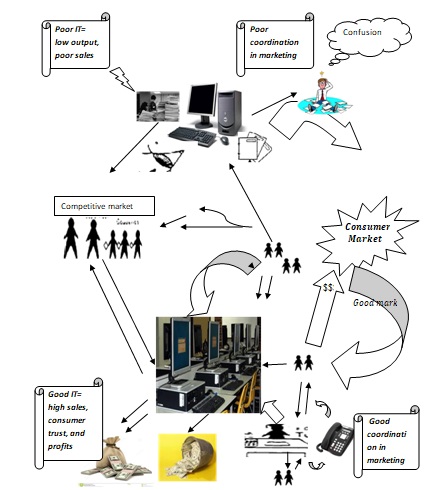
Stage Three: Relevant Systems, Root Definitions, and Their Conceptual Models
Aspect of Competitive Advantage
Stage three of the SSM involves conceptualizing ideas through the mnemonic CATWOE checklist framework to give certain aspects in the problem or scenario an indefinite systematic meaning (Kenny & Shannon 2009). From the case of Bryant Homes, this analysis discovers that the use of appropriate information technology systems, including intranet and internet IT programs, enhances the competitive advantage of Bryant Homes. Competitive advantage is the transformative aspect. Bryant Homes (O) has an established IT system that supports an efficient marketing process for (W) products and services. Strategic integration (E) of IT in marketing by the IT department of Bryant (A) boosts marketing processes (T) of Bryant Homes Company (C).
Conceptual Model
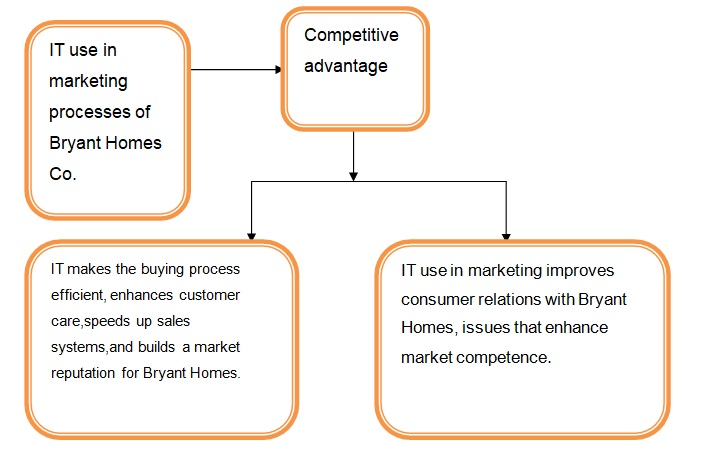
Customer’s Efficiency in Purchasing
The case of Bryant Homes demonstrates the efficiency of technology in terms of its ability to make information readily and broadly available for consumers and speeding up sales systems, which makes purchasing undemanding. The aspects of convenience, efficiency, and swiftness demonstrate the transformative aspect of marketing that helps consumers in their purchasing processes. The CATWOE definitions: Appropriate integration and use (E) of information technology by the IT department (A) of Bryant Company (O) provides customers (C) with reliable, accurate, and comprehensive information (W) that spurs efficiency in the company since it speeds up sales systems (T).
Conceptual Model
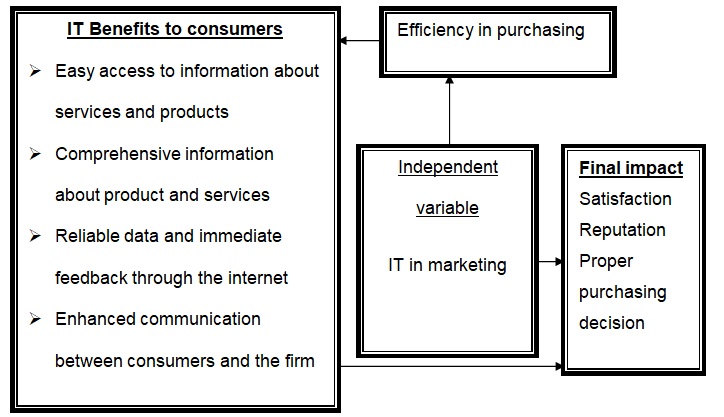
Improved Decision-Making
From the case of Bryant Homes, the perception created about the use of technology is that with the enhanced communication among the staff, company departments, and improved marketing of goods and services through communication technologies, Bryant managers are able to make informed decisions. The CATWOE framework: the appropriate (E) integration of intranet and internet (W) information technologies in Bryant Homes (O) by the IT department (A) has improved its corporate communication (T). Consequently, improvement in communication has assisted Bryant managers (C) in speeding up management decisions.
Conceptual Model
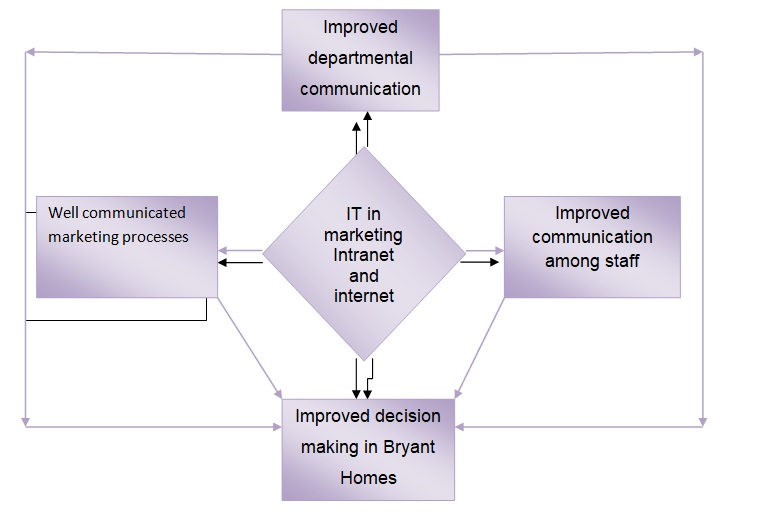
Other Relevant Thinking Approaches
Apart from the soft and the hard thinking system approaches, there are other methodologies of assessing a problem or a scenario in an organization, society, or a scientific phenomenon. One of the most essential analysis tools commonly used by evaluators and analysts is the SWOT analytical instrument (Sorensen & Vidal 2007). SWOT represents Strengths, Weaknesses, Opportunities, and Threats associated with an organization or a situation in an organization (Sorensen & Vidal 2007). IT integration has its strengths in marketing as Bryant Homes case presents them, but also has its weaknesses, opportunities, and threats. The following conceptualized diagram presents the SWOT for IT in Bryant Homes.
Conceptualized SWOT for IT in Bryant Homes
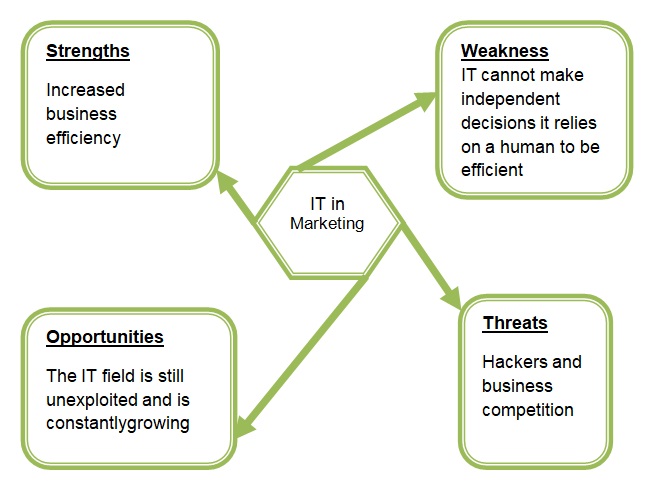
Conclusion
Analysts can view a problem, a behavior, or a situation in the real world or from an assumptive angle using various systems of thinking. Soft System Methodology of thinking and SWOT analysis tools are among the most effective thinking systems of approaching a situation or a problem in an organization from the conceptual reasoning in a realistic manner. Bryant Homes is a case of IT as a transformative aspect and not a problematic scenario, but has all the important variables required for the SSM analysis technique. Analysis of organizations using SSM models offers a soft methodology, which enhances the understanding of complex issues that cloud most organizations. In this case, since Bryant Homes has an extensive network of IT, it requires SSM analysis to unravel complex issues that are inherent in both the intranet and the internet. Moreover, SSM offers an effective view of understanding marketing strategies that Bryant Homes need to employ in its bid to gain extensive market share.
References
Kenny, S & Shannon, P 2009, ‘Using soft systems methodology to support extension program development in the dairy industry’, Extension Farming Systems Journal, vol. 6, no. 1, pp. 123-128.
Kotiadis, K 2007, ‘Using soft systems methodology to determine the simulation study objectives’, Journal of Simulation, vol. 1, no. 3, pp. 215-222.
Sorensen, L & Vidal, R 2007, ‘Evaluating Six Soft Approaches’, Economic Analysis Working Papers, vol. 7, no. 9, pp. 1-20.
Williams, B 2005, Soft Systems Methodology. Soft Systems Methodology, Web.
